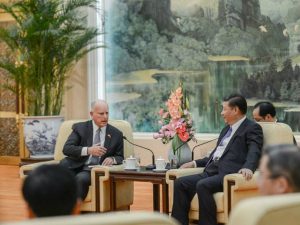Does US president Donald Trump’s decision to pull out of the Paris Agreement on climate change mean the end of the positive US-China relationship on global warming that was so hard-won?
Closely linked to this question, is that of who will fill the leadership gap created by the US departure, and how.
There is no doubt that US withdrawal from the Paris Agreement weakens global efforts to tackle climate change: it is the world’s second largest carbon-emitting nation.
More positively, the US is also the most important source globally of technologies for energy conservation and emissions reduction.
Damage
Clearly, there is little immediate prospect of the US and China deepening their climate change discussions in multilateral forums.
Negative impacts include the loss of a route to strengthen the Sino-US bilateral relationship and improve strategic trust, and damage to a plurality of partnerships. The many research initiatives and industrial pilots — covering clean energy, smart cities, and the water-energy-climate nexus — created by the Strategic and Economic Dialogues of the Obama-Xi era have been severely weakened.
Strong synergies
The question for the way ahead is how US-China climate cooperation can continue to deepen without US federal government support? What could this cooperation look like?
Synergies in the two countries’ priorities hint at an answer.
China wants to pursue low-carbon development, upgrading and restructuring its industrial base to become more sustainable. Yet it lacks low-carbon technologies, information transparency, and suitable financial mechanisms.
China wants to pursue low-carbon development yet lacks technologies, information transparency and financial mechanisms.
Although the current US administration has no interest in leading on climate change, US industry and researchers possess great authority and leadership in these fields. There is enormous potential and impetus for corporate and regional cooperation from the bottom up.
Stay practical
Tackling climate change touches all areas of social life – industrial structure, air and marine transport, land use, renewable energy, carbon pricing, data transparency, efficient use of finance, lifestyles and value systems.
By paying attention to these practical issues, China’s government departments can implement measures that will encourage partnerships with US organisations and uncover hidden potential.
Government and non-government actors can still take action based on their value systems and market forces, regardless of reduced US government funding.
The US remains involved in multilateral mechanisms on many of these issues, so there is room for action there too.
Market forces
Most importantly, China’s low-carbon market is enormous; demand is strong, but capacity building remains weak.
The US is a leader in advanced technologies, and firms adapt quickly. Many US environmental companies are seeking to grow their share of China’s environmental services market and devise fresh products.
Although China aims to develop its own path, it also needs assistance from foreign – particularly US – companies.
Furthermore, climate change is a classic example of a complex, multi-layered problem, where we cannot rely solely on a top-down approach and must work from the bottom up too.
Stay local
In addition to the Paris Agreement, there are municipal and corporate emissions reduction frameworks and alliances, like the C40 Cities Climate Leadership Group, made up of nearly 100 cities, and its spin-off, the Compact of Mayors.
There is plenty of scope for action at municipal level.
For instance, research by the New Climate Economy project (supported by former heads of government, ex-finance ministers and current business leaders) examined 100 major cities, and discovered that only 29 out of 60 cities publishing carbon emissions data had clarified the scope of data coverage.
This suggests few cities are able to take informed and data-driven action, or integrate their actions into their countries’ nationally determined contributions (NDCs) to emissions cuts.
Chinese and US cities within these frameworks can promote cooperation. Companies can also take action through emissions-reduction alliances, by creating opportunities for technological and financial support through the international financial market and multilateral organizations, and by improving their own performance in climate governance.
The potential and drivers for US-China climate cooperation remain strong; the US government’s choice to leave the Paris Agreement need not reduce or halt climate action.
The potential and drivers for US-China climate cooperation remain strong.
For now, we must consider how China can engage in climate action on different administrative levels and issues, preserve former gains, and seek climate partnerships in all aspects with the United States in the face of conservative passivity in the American government.
The answer is for China to focus on strengthening its capacity in sustainable development rather than paying over-much attention to international talks.







